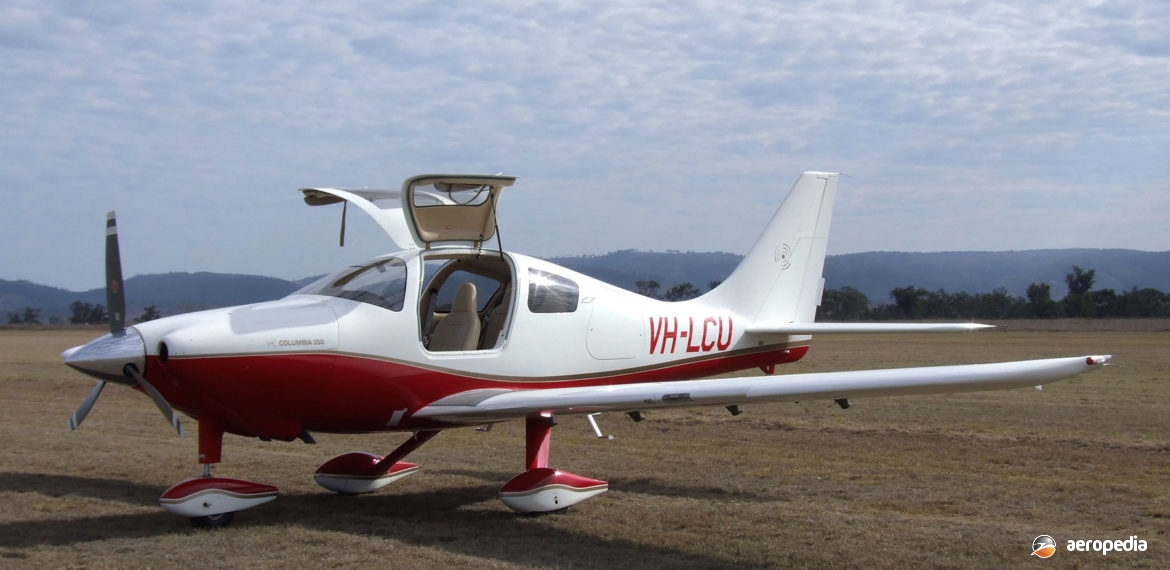Photograph:
Colombia 350 demonstrator VH-LCU (c/n 42075) at Watts Bridge, QLD in August, 2006 (David C Eyre)
Country of origin:
United States of America
Description:
Four-seat light touring monoplane
Power Plant:
One 230 kw (310 hp) Teledyne Continental TSIO-550-C twin turbocharged, direct drive, fuel injected six-cylinder horizontally-opposed air-cooled engine
Specifications:
- Wingspan: 10.91 m (35 ft 9 in)
- Length: 7.68 m (25 ft 2 in)
- Height: 2.74 m (9 ft)
- Wing area: 13.1 m² (141.01 sq ft)
- Max cruising speed at 5,486 m (18,000 ft): 406 km/h (252 mph)
- Cruising speed at 3,048 m (10,000 ft): 378 km/h (235 mph)
- Stalling speed, flaps down: 109 km/h (68 mph)
- Max rate of climb: 427 m/min (1,400 ft/min)
- Max operating altitude: 5,486 m (18,000 ft)
- Take-off run: 366 m (1,200 ft)
- Landing run: 579 m (1,900 ft)
- Range with 45 mins reserve: 2,093 km (1,301 miles)
- Max endurance: 7.4 hours
- Empty weight: 1,179 kg (2,600 lb)
- Max payload: 454 kg (1,000 lb)
- Loaded weight: 1,633 kg (3,600 lb)
History:
Following the success of the Neico Lancair series of kitplanes, Lance Neibauer designed a production certificated aircraft based on the four-seat Lancair ES and set up a separate company to build and market the new type. First in the series was the Colombia 300. This was followed by the Colombia 350, an all-electric variant of the 300 with a 230 kw (310 hp) Teledyne Continental engine which featured a dual battery electrical system which eliminated the dual vacuum pumps on the 300, with a PowerLink FADEC controlled TCM IO-550N engine as an option. By 2005 production had reached ten aircraft a month and during that year 114 aircraft were delivered.
The Model 350 was followed by the Colombia 400 with a twin-turbocharged engine and an oxygen system. This model was a logical progression of the earlier models and was aimed at the market for a higher performance aircraft capable of 404 km/h (251 mph) with a range of over 1,852 km (1,151 miles). It was designed as a stable and safe long-distance aircraft with high cruising speed. It is of all-composite construction and had a fixed tricycle undercarriage, the main undercarriage legs being mounted on the underside of the fuselage rather than below the wing, this being done to avoid the cost of certifying a retractable undercarriage aircraft and thus reduce the costs associated with maintenance.
Construction took place at the Company’s facility at Bend in Oregon. Electric ailerons and elevator trim were standard, but the rudder trim was not adjustable in flight. The 400 featured a larger fin and rudder, a ventral strake to improve directional control and stability, and was fitted with electrically actuated speed brakes. Control was by side-sticks and instrumentation by two Avidyne EFIS screens. A modified Colombia 300 was flown non-stop from New York to Paris by Erik Lindbergh, grandson of Charles Lindbergh, to honour his grandfather’s flight in 1927 in a Ryan Brougham.
First of the type in this region was a Colombia 350 VH-LCU (c/n 42075 – ex N1475W) registered to Colombia Down Under of Tewantin, QLD in August 2005, this aircraft being imported as a demonstrator, being followed in 2007 by Colombia 400 VH-LCW (c/n 41732). Another Colombia 400 became VH-XTU (c/n 40018 – ex N189TC) on 10 January 2018.
In late 2007 Cessna, a subsidiary of Textron, obtained Colombia Aircraft, which was building the type at Bend, Oregon. It obtained the Company at a bankruptcy auction. At the time it announced it would be continuing to produce the Colombia 350 and 400 and they would be known as the Cessna 350 and Cessna 400. The dealers and service centres would integrate them into the Cessna system. Later they became known as the Cessna 350 Corvalis and the 400 Corvalis TT, the TT standing for twin turbocharged. Cessna closed the production facility where they were built and moved it to a Cessna facility at Independence in Mexico, the composite construction of the aircraft being transferred to Mexico.

